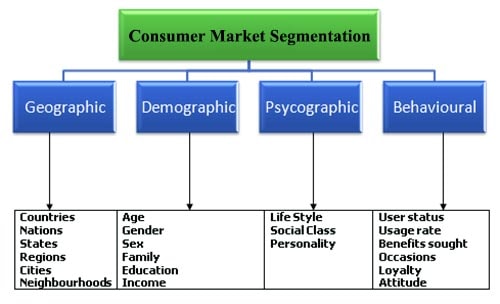- Bases for Consumer Market Segmentation
There is a number of variables involved in consumer market segmentation, alone and in combination. These variables are:
- Geographic variables
- Demographic variables
- Psychographic variables
- Behavioural variables

1. Geographic Segmentation
In geographical segmentation, a market is divided into different geographical units like:
- Regions (by country, nation, state, neighbourhood)
- Population Density (Urban, suburban, rural)
- City size (Size of the area, population size, and growth rate)
- Climate (Regions having similar climate pattern)
A company, either serving a few or all geographic segments, needs to put attention on the variability of geographic needs and wants. After segmenting consumer market on geographic bases, companies localize their marketing efforts (product, advertising, promotion and sales efforts).
2. Demographic Segmentation
In demographic segmentation, the market is divided into small segments based on demographic variables like:
- Age
- Gender
- Income
- Occupation
- Education
- Social Class
- Generation
- Family size
- Family life cycle
- Home Ownership
- Religion
- Ethnic group/Race
- Nationality
Demographic factors are most important factors for segmenting the customer’s groups. Consumer needs, wants, usage rate these all depend upon demographic variables. So, considering demographic factors, while defining marketing strategy, is crucial.
3. Psychographic Segmentation
In Psychographic Segmentation, segments are defined on the basis of social class, lifestyle and personality characteristics.
Psychographic variables include:
- Interests
- Opinions
- Personality
- Self Image
- Activities
- Values
- Attitudes
A segment having demographically grouped consumers may have different psychographic characteristics.
4. Behavioural Segmentation
In this segmentation, the market is divided into segments based on consumer knowledge, attitude, use or response to a product.
Behavioural variables include:
- Usage Rate
- Product benefits
- Brand Loyalty
- Price Consciousness
- Occasions (holidays like mother’s Ne\N Year and Eid)
- User Status (First Time. Regular or Potential)
Behavioural segmentation is considered most favourable segmentation tool as it uses those variables that are closely related to the product itself.
- Bases for Business Market Segmentation
Business market can be segmented into the bases consumer market variables but because of many inherent differences in
- Businesses are few but purchase in bulk
- Evaluate in depth
- Joint decisions are made
The business market might be segmented on the bases of following variables:
- Company Size: what company sizes should we serve?
- Industry: Which industry to serve?
- Purchasing approaches Purchasing-function organization. Nature of existing relationships, purchase policies and criteria.
- Product usage
- Situational factors: seasonal trend. urgency: should serve companies needing quick order delivery. Order: focus on large orders or small.
- Geographic: Regional industrial growth rate. Customer concentration, and international macroeconomic factors.












